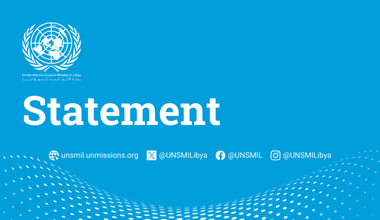Human Rights Report on Civilian Casualties - June 2017
Tunis, 1 July 2017 – From 1 June to 30 June 2017, the United Nations Support Mission in Libya (UNSMIL) documented 26 civilian casualties - 9 deaths and 17 injuries – during the conduct of hostilities across Libya. Victims included 6 men killed and 12 injured, 2 women killed and 1 injured and 1 child killed and 4 children injured.
Civilian Casualties
The majority of civilian casualties were caused by gunfire (7 deaths and 12 injuries), followed by Explosive Remnants of War (ERW, 2 deaths) and a Vehicle Borne Improvised Explosive Device (VBIED, 4 injuries). Another civilian sustained a stabbing injury.
UNSMIL documented 3 deaths and 7 injuries in Benghazi, 2 deaths and 1 injury in al-Zawiya, 1 death and 6 injuries in Sabha, 1 death and 3 injuries in Misrata, 1 death in Tripoli, 1 death in Hun.
The civilian casualties included two men killed in crossfire during clashes between armed groups in the city of al-Zawiya on 3 June. On 28 June, a UN staff member sustained a minor injury when a UN convoy came under fire in western al-Zawiya by local gunmen.
On 6 June, a settlement for Internally Displaced Persons (IDPs) from Benghazi in the city of Misrata came under attack by a group of armed men, who shot in the air. A man in the settlement was then stabbed following a verbal dispute. On the same day, a car carrying a Benghazi IDP family came under fire at a roundabout in Misrata by a man allegedly affiliated to a local armed group, resulting in the death of a 38 year old woman, and the injury of her two sons, aged 12 and 8.
In Benghazi, two men were killed as a result of ERWs in the area of Qawarsha in two separate incidents. On 10 June, 4 men were injured in a VBIED attack apparently targeting the mayor of Benghazi.
On 26 June, a man died and 6 other civilians (3 men, 2 children and 1 woman) were injured in tribal armed clashes in Sabha.
UNSMIL was unable to determine with certainty which parties to the conflict caused the other civilian casualties in June.
Civilian Facilities
On 3 June, patients were evacuated from the main hospital in the city of al-Zawiya as a result of armed clashes in the vicinity. The hospital remained closed for several days following the incident.
Other Casualties
During June, two videos emerged on social media depicting the apparent summary executions of 6 men in eastern Libya. In both videos, a Benghazi field commander of the Special Forces, Mahmoud al-Werfalli, is clearly identifiable. The same commander appeared in earlier videos of summary executions (see March and May 2017 Human Rights Report on Civilian Casualties).
On 4 June, 7 sub-Saharan African migrants suffocated inside a truck, allegedly after being locked in and abandoned by smugglers in the area of Garabulli. Officials with the Ministry of Interior uncovered the truck with deflated tires, but apparently did not open the doors until hours later once it was towed to Tripoli.
On 19 June, the body of a Tawerghan man, who had found shelter at the Tarik al-Matar IDP camp in Tripoli following the 2011 armed conflict, was brought to a Tripoli morgue, bearing signs of beatings and fractures. He has been seized a few days earlier.
Note
The figures for civilian casualties set out above only include persons killed or injured in the course of hostilities and who were not directly participating in the hostilities. The figures do not include those casualties that are not a direct result of hostilities, for example executions after capture, torture or abductions, or casualties caused as an indirect consequence of hostilities. The figures are based on information UNSMIL has gathered and cross-checked from a broad range of sources in Libya, including human rights defenders, civil society, current and former officials, employees of local governments, community leaders and members, witnesses, others directly affected and media reports. In order to assess the credibility of information obtained, where possible, UNSMIL reviewed documentary information, including medical records, forensic reports and photographic evidence.
The figures are only those that UNSMIL was able to document in the reporting period. They are not likely to be complete and may change as new information emerges about incidents involving civilian casualties that took place during this period.
Similarly, while UNSMIL has systematically tried to ensure that the cases it documented are based on credible information, further verification would be required to attain a higher standard of proof. Due to the security situation, UNSMIL has not been able to carry out direct site visits to all relevant locations in Libya to obtain information. Fear of reprisals against sources further hamper information gathering.
While not all actions leading to civilian casualties breach international humanitarian law, UNSMIL reminds all parties to the conflict that they are under an obligation to target only military objectives. Direct attacks on civilians as well as indiscriminate attacks – which do not distinguish between civilians and fighters – are prohibited. Attacks that are expected to cause incidental loss of civilian life, injury to civilians and damage to civilian objects excessive to the anticipated concrete and direct military advantage are also prohibited. Such attacks amount to war crimes that can be prosecuted by the International Criminal Court.
In order to ensure greater protection of the civilian population and essential infrastructure, all parties engaged in fighting in Libya must cease the use of mortars and other indirect weapons and imprecise aerial bombardments in civilian-populated areas, and not place fighters or other military objectives in populated areas. All executions of captives must cease and all those captured including fighters must be treated humanely in all circumstances. Murdering or torturing captives is also a war crime, regardless of what the captive may be accused of.
 United Nations Peacekeeping
United Nations Peacekeeping UN
UN









